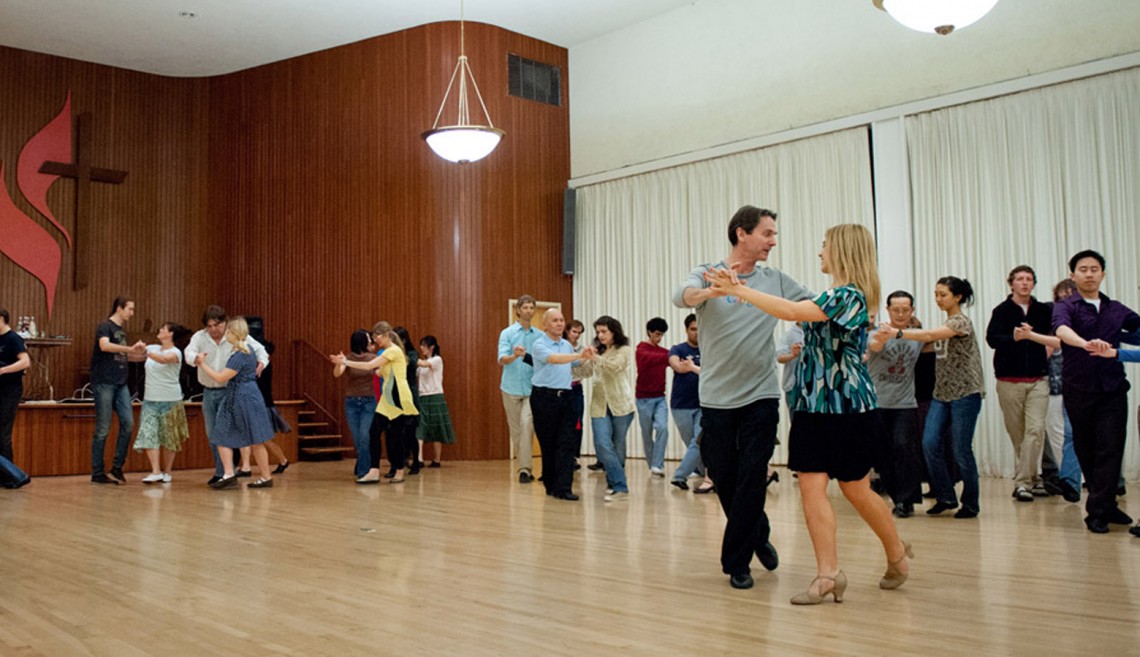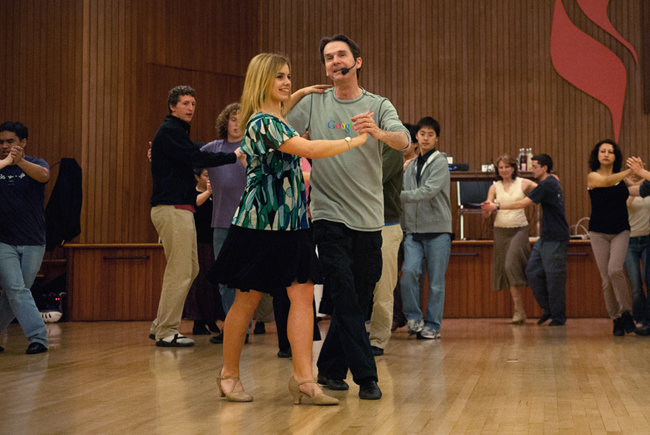
Google Waltz Lab teaches Stanford students to think on their feet
Renowned Stanford dance instructor Richard Powers teaches the value of improvisation on the dance floor and beyond.
It’s Monday night, and for Stanford senior Acata Felton that means one thing: dancing. Taking a break from work on her marine biology honors thesis, Felton is waltzing the night away at theGoogle Waltz Lab, led by Stanford’s renowned dance instructor Richard Powers.
A video of Felton and her dance partner experimenting with a new iteration of a classic waltz pivot has already received positive feedback from some of the hundreds of other dancers who viewed it online. Felton is eager to get to the Lab so she can further test and modify the move.
Theirs is just one of nearly 100 video clips produced by dancers that have been posted on the Google Waltz Lab website. In just over a month, participants in the class at Google, as well as dancers from around the globe in satellite classes, have been submitting videos of themselves experimenting with variations on classical waltz steps. The online forum allows them to provide feedback for one another.
Resulting from a partnership between Google and Powers, a Stanford Dance Division lecturer, the lab is much more than just a dance class. Building on the non-competitive activity of social ballroom dancing, the students learn not just to dance, but also to think about problem-solving in a new light. As Felton said, “The lab is playtime, and it’s the ultimate designer’s challenge – be creative on demand.”

Jason Chuang
One dancer, Nick Enge, is in the final quarter of his master’s degree in Earth systems at Stanford. He describes the Lab’s website as a departure from typical online teaching by enabling a “many-to-many education” format, in which anyone can become the teacher.
The initiative began as a weekly dance class offered to Google employees at Danceplex, a dance studio located on Google’s Mountain View campus, but the dancing will soon be moving to the Stanford campus. Taught by Powers, the project has continued to expand, with his Stanford students and people from all over the world posting and commenting on videos.
Another Waltz Lab contributor, Linda Townsend West of Seattle, put the Waltz Lab in a historic perspective. The Lab is “essentially like what happened at the Savoy Ballroom … brought into the 21st century – people watching other people dance and ‘stealing’ their stuff and changing it. Except that now they aren’t all standing in the same room at the same time (or even in the same country, or the same continent).”
Students learn to think with their bodies
The dancers’ development process occurs in two parts. In Round One, a collection of videos from dancers improvising off of the featured waltz move of the week, such as “pivots” or “role-reversal,” is accumulated. These variations on the theme taken from Powers’ Monday night class at the Danceplex are then posted on the lab’s website in the Round One category.
Round One is liberating, according to Felton, because “You are definitely not innovating in a vacuum. You are dancing with different people, reacting, trying things … thinking with your body, not your mind.” Learning to think with her body, she said, is the most important thing the Waltz Lab has done for her as a student.
Round Two takes place primarily on the website through the video submissions of other dancers’ variations on the material from Round One. Many of the themes feature variations on the cross-step waltz, a form that Powers says is ideal for innovating because, “It is easy to break out of the frame and move into a swing move, salsa move or tango move at one count.”
Recognizing the power of observation
A secondary aim of this initiative is to revive the art of learning by observation. A practice that was once prevalent among academic and artistic communities is one that Powers feels is neglected far too often. With the emphasis placed on testing and memorization in the No Child Left Behind Act, learning by observation may be at risk of extinction, he said.
Waltz Lab participants are encouraged to listen to their guts and incorporate vertical and lateral thinking into the creative process. As Powers says on the website, “Welcoming chance intrusions into what you’re expecting is one of the fundamental components of creative thinking.”
And Richard Powers would know. He holds a master’s degree from Stanford in creative process, a self-designed track devoted to examining the roots of innovation across the humanities, engineering and social sciences. He worked in technology for a decade, as vice president of Genesis Design Group in Cincinnati, and holds seven U.S. patents. But he eventually followed his passion for social dance into a performing arts career, winning the City of Cincinnati’s Post-Corbett Award as Artist of the Year in 1992, the same year he came to work in Stanford’s Dance Division.
Waltz Lab students have found that the improvisational skills they learn in the dance experiments enhance other facets of their academic life.
Enge is considering a career in teaching social dance. In his experience he has seen the benefits from this process extend far beyond the dance floor, helping people move in a direction that he describes as “positive for themselves and the world … much more quickly than anything I saw when working on environmental issues.”
“While the community we are building is awesome, the ability to think with your body – your instincts, your intuition – and not your rational, meticulous, ‘Let’s dissect everything’ part of your brain, is the best part,” Felton said. “You no longer need someone to break every little thing down for you. You are willing to make mistakes, to embrace them.”
Waltz Lab headed to campus
If the rapid growth experienced by the site since its creation in January is any indication, Felton is not alone in her enthusiasm. The Waltz Lab website regularly attracts submissions from all over the United States, as well as viewers from France, the United Kingdom, Hong Kong, Singapore, Sweden, India and New Zealand.
With the Lab slated to move from the Danceplex to Stanford in April, the spectrum of perspectives will only continue to increase. According to Powers, this move came about as a direct response to the on-campus “excitement and energy for the project.”
The hour-long Waltz Labs will be held at 9 p.m. on Mondays at the Roble Dance Studio on campus. These classes will be primarily for Stanford students, but also open to the Google employees who are taking the current Danceplex series. The online Second Rounds will continue, with participation by dancers anywhere in the world creating new variations and adding their videos to the growing Waltz Lab collection of waltz innovations.
